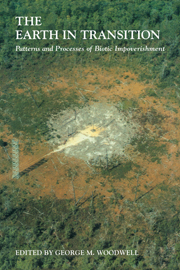Book contents
- Frontmatter
- Contents
- Preface
- Acknowledgments
- List of Contributors
- Part I Global Change and the Patterns of Impoverishment
- Part II Chronic Disturbance and Natural Ecosystems: Forests
- Part III Chronic Disturbance and Natural Ecosystems: Woodlands, Grasslands, and Tundra
- Part IV Chronic Disturbance and Natural Ecosystems: Aquatic and Emergent Ecosystems
- 18 Changes in a Red Sea Coral Community Structure: A Long-Term Case History Study
- 19 Are Deep-Sea Communities Resilient?
- 20 Species Dominance–Diversity Patterns in Oceanic Communities
- 21 Natural and Anthropogenically Imposed Limitations to Biotic Richness in Fresh Waters
- 22 Human Impacts on the South Florida Wetlands: The Everglades and Big Cypress Swamp
- 23 The Impoverishment of Aquatic Communities by Smelter Activities near Sudbury, Canada
- 24 Biotic Impoverishment: Effects of Anthropogenic Stress
- Part V Conclusion: Steps toward a World That Runs Itself
- Name Index
- Subject Index
22 - Human Impacts on the South Florida Wetlands: The Everglades and Big Cypress Swamp
Published online by Cambridge University Press: 24 November 2009
- Frontmatter
- Contents
- Preface
- Acknowledgments
- List of Contributors
- Part I Global Change and the Patterns of Impoverishment
- Part II Chronic Disturbance and Natural Ecosystems: Forests
- Part III Chronic Disturbance and Natural Ecosystems: Woodlands, Grasslands, and Tundra
- Part IV Chronic Disturbance and Natural Ecosystems: Aquatic and Emergent Ecosystems
- 18 Changes in a Red Sea Coral Community Structure: A Long-Term Case History Study
- 19 Are Deep-Sea Communities Resilient?
- 20 Species Dominance–Diversity Patterns in Oceanic Communities
- 21 Natural and Anthropogenically Imposed Limitations to Biotic Richness in Fresh Waters
- 22 Human Impacts on the South Florida Wetlands: The Everglades and Big Cypress Swamp
- 23 The Impoverishment of Aquatic Communities by Smelter Activities near Sudbury, Canada
- 24 Biotic Impoverishment: Effects of Anthropogenic Stress
- Part V Conclusion: Steps toward a World That Runs Itself
- Name Index
- Subject Index
Summary
Editor's Note: The Everglades of southern Florida are a subtropical wetland, unique in North America but taken here as an example of wetlands globally. They are as unusual and rich as the Anavilhanas of the Rio Negro, the Pantanal of the southwestern Amazon Basin, and the moist prairies of North America. They have suffered a succession of disruptions, including hunting, logging, fire, abrupt and fundamental changes in the water regime, and the encroachment of farms with their toxins aimed at “pests.” William Niering, an indefatigable student of ecology and a fountain of knowledge, points to the richness of the region by observing that it supports more than 1,000 species of higher plants, 300 species of birds, 60 species of reptiles and amphibians, and 25 species of mammals. Its role in maintaining fisheries of the southern coasts is certain, yet poorly known.
The Everglades are vulnerable and are being encroached upon rapidly. The patterns of change are familiar; the causes, textbook cases. But the effects are diffuse, erratic, difficult to codify, open to interpretation and argument. They become clear when species are threatened, habitats lost, water flows disrupted, whole populations eliminated. At that point they appear to be isolated disasters, such as a fish kill, caused by some quirk of environment and of no general significance. Niering has summarized these changes on the basis of years of experience. He treats the scholarly and the political as inseparable, which they are.
- Type
- Chapter
- Information
- The Earth in TransitionPatterns and Processes of Biotic Impoverishment, pp. 463 - 476Publisher: Cambridge University PressPrint publication year: 1991



